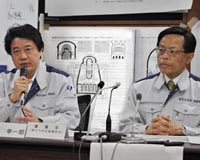 |
Kitakami, Japan (AFP) March 27, 2011 Dangerous levels of radiation detected in water thought to be leaking from a stricken Japanese reactor dealt a new setback Sunday to efforts to avert a nuclear disaster. Radiation in puddles near reactor two at the Fukushima plant was more than 1,000 millisieverts per hour, forcing the evacuation of workers toiling to restore the cooling systems, operator Tokyo Electric Power (TEPCO) said. "It is an extremely high figure," nuclear safety agency spokesman Hidehiko Nishiyama said, adding there was a "high possibility" that the contaminated water had leaked from the reactor. A single dose of 1,000 millisieverts can cause temporary radiation sickness, including nausea and vomiting. An exposure of 100 millisieverts per year is considered the lowest level at which an increase in cancer risk is evident. TEPCO said the concentration of radioactive substances in the water was 100,000 times higher than would usually be found in water in a reactor core, correcting an earlier assessment which said it was 10 million times higher, Kyodo News reported. Workers were trying to pinpoint the exact source of the radioactive water leak, but there are concerns that fuel rod vessels or their valves and pipes are damaged. A key concern is how to safely pump away the highly radioactive water, but chief government spokesman Yukio Edano admitted progress at the site was slow. "It will take some time in order to remove the water while ensuring the safety of workers," Edano told a press conference. There was also a warning from Yukiya Amano, director general of the International Atomic Energy Agency, that the emergency could go on for weeks, if not months, given the damage to the plant, The New York Times reported. An update on the agency's website said the situation at the Fukushima plant "remains very serious." Last week three workers received medical treatment after stepping in radioactive water during efforts to install cables and restore critical reactor cooling systems. The incident heaped more pressure on the plant operator because two were hospitalised after wearing inadequate safety gear. But officials said Sunday the three would be discharged from medical care with no sign of serious injuries, apparently because they suffered only localised exposure to their feet. The March 11 magnitude 9.0 earthquake and huge tsunami left more than 27,000 people dead or missing, wiping out entire towns. The wave knocked out cooling systems for the six reactors at the Fukushima plant, leading to suspected partial meltdowns in three of them. Hydrogen explosions and fires have also ripped through the facility. Fire engines have hosed huge amounts of seawater onto the plant to try to keep the fuel rods inside reactor cores and pools from being exposed to the air, and prevent a full meltdown. Olivier Isnard, an expert with the French Institute for Radiological Protection and Nuclear Safety, said the reading of 1,000 millisieverts in the water at the plant was "proof that the reactor core partially melted." Several hundred metres (yards) offshore, levels of radioactive iodine some 1,850 times the legal limit were reported Sunday, up from 1,250 times on Saturday, but officials ruled out an immediate threat to marine life and seafood safety. Around 500 technicians, firefighters and soldiers are battling day and night to contain Japan's worst ever atomic accident. The nuclear safety agency on Sunday said workers hoped to start using electric pumps instead of fire trucks for cooling operations at reactor number one. High-voltage electric cables have been reconnected to the reactors and power has been partially restored to enable lighting in some reactor control rooms. Worried about the possible corrosive effect of salt in the crippled plant, engineers have started pumping fresh water into some of the reactors. Radioactive vapour seeping from the plant has contaminated tap water and farm produce in the region, leading to shipment halts in Japan as well as the United States, European Union, China and a host of other nations. A Kyodo survey showed 58.2 percent of respondents disapproved of the government's handling of the nuclear crisis.
Share This Article With Planet Earth
Related Links Space Technology News - Applications and Research
 Japan says people should leave 30km nuke plant zone
Japan says people should leave 30km nuke plant zoneOsaka (AFP) March 25, 2011 Japan's government on Friday asked people still living within 20-30 kilometres (12-18 miles) of the stricken Fukushima nuclear plant to leave voluntarily, after it earlier told them to stay indoors. Hundreds of thousands of residents were evacuated from within a 20 km radius of the plant in the days after it was damaged by the March 11 earthquake and tsunami which disabled its crucial coolin ... read more |
|
| The content herein, unless otherwise known to be public domain, are Copyright 1995-2010 - SpaceDaily. AFP and UPI Wire Stories are copyright Agence France-Presse and United Press International. ESA Portal Reports are copyright European Space Agency. All NASA sourced material is public domain. Additional copyrights may apply in whole or part to other bona fide parties. Advertising does not imply endorsement,agreement or approval of any opinions, statements or information provided by SpaceDaily on any Web page published or hosted by SpaceDaily. Privacy Statement |